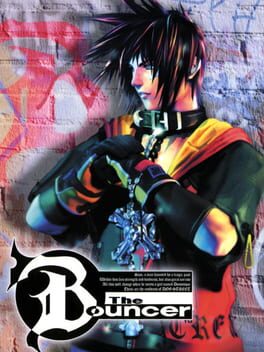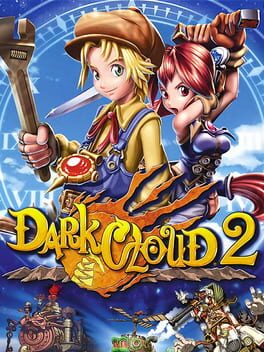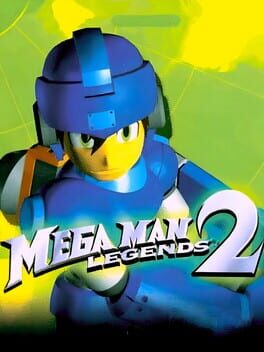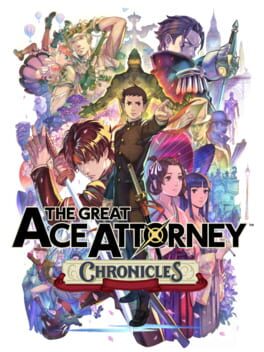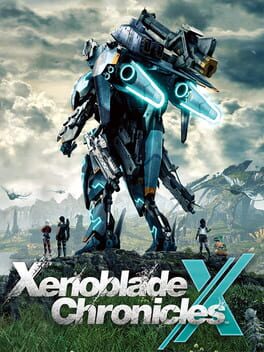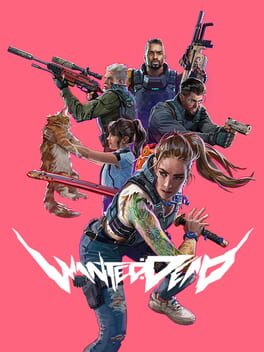Trance
7 reviews liked by Trance
The Bouncer
2000
Dark Cloud 2
2002
This game is so much. All the ideas from the first are brought over, but with better combat, item crafting via combining photos of different objects that you take, time travel mechanics that are added to the city building mode... and a golf minigame that's set inside the randomized dungeons. I've never finished this game but it's pretty great.
Mega Man Legends 2
2000
For followers of the Ace Attorney franchise, Dai Gyakuten Saiban appeared to be an unattainable mirage. Released in 2015 and never localised, the title was a distant beacon that players were desperately trying to experience. The situation had already happened in the past with Gyakuten Kenji 2 (2011). The game was a follow-up to the first spin-off which already featured Miles Edgeworth. In that case, the combination of the disappointing sales of the first opus and the impossibility of splitting the localisation team on both Gyakuten Kenji 2 and the upcoming Dual Destinies (2013) prevented the game from being released outside Japan. The Ace Attorney community being tenacious, they set about an unofficial translation, the quality of which must be underlined for amateur work. Thus, it was the Scarlet Study team that took on the unofficial translation of Dai Gyakuten Saiban, shortly after a playthrough with English subtitles was released online.
A titanic task if ever there was one. This fan localisation also shines through in its tendency towards professionalism and was well on its way to completing the entirety of the two games released, before leaks took the public by surprise, announcing the official localisation in a single collection, The Great Ace Attorney Chronicles. The following months would confirm these rumours and the localisation was carried out by Janet Hsu, whose challenge here is particular. Unlike the main series, for which the localisation embraced an Americanisation of all Japanese place names and cultural markers, The Great Ace Attorney only makes sense by respecting the spirit and letter of the terms used.
Indeed, the title places us in the shoes of Ryunosuke Naruhodo, ancestor of Phoenix Wright, and young Japanese student. His adventures will lead him to become a defence lawyer and to cross the globe to settle in the Victorian United Kingdom, with Herlock Sholmes. He is accompanied by Susato Mikotoba, a legal assistant caught in the conservative fire of legal institutions. This historical context is the cornerstone of the title's social and political discourse, as well as the narrative economy, so that it is impossible to transpose Meiji era Japan to a fantasy creation that copies the United States. This historical stability thus brings an element of complexity, since it is a question of translating dialogues, but also a continuum of reactions – drawn from reality – that underlie behaviours at the turn of the 20th century.
It would be difficult for me to set out here all the issues related to translation, as they are so rich and plural. Nevertheless, I would like to insist briefly on the ability to transcribe strangeness in the official localisation, something that is lacking in the fan localisation. Indeed, for a Western audience – especially if they are familiar with the mysteries of the Golden Age of Detective Fiction – the Victorian spirit should not be too disorienting. For our protagonists, the situation is quite different, and conveying this impression of surprise and novelty is a difficult operation, when all the text is in English. Susato and Ryunosuke use idioms and comparisons with Japanese elements to express their perplexity and it is the translation of such elements that is the great challenge of the localisation. For more on this, I can only recommend the extremely interesting blog posts by Janet Hsu.
But what about the game itself? I'm not ashamed to say that the title has quickly become one of my favourite games, crowning an exceptional franchise in my opinion. The Ace Attorney formula is generally well known: a succession of four or five cases, in which our protagonist alternates between investigation and trial sequences. In the former, the gameplay is close to traditional point&clicks, in a tradition that may remind us of The Portopia Serial Murder Case (1983) and all the games that follow. The trial phases are visual novels with cross-examination sequences where the aim is essentially to dismantle the testimonies by pointing out the contradictions they have with the case file. If the formula has always worked well, it must be said that certain recurrent criticisms point to the length of the investigation phases and a certain artificiality in the rhythm of the cases. I agree with them overall and was very surprised to see that The Great Ace Attorney Chronicles sweeps away these problems with exceptional ease.
For the first five cases, the pace is impeccably supported by a single investigative sequence, followed by the trial court portion. Even when the traditional formula returns for the last four cases, the pace is judiciously thought out, thanks to an elegant tangle of narrative threads. Indeed, in the vein of Gyakuten Kenji, The Great Ace Attorney has several overarching mysteries, within which are nestled smaller mysteries, solved with each case. This matriochka structure keeps the dramatic tension high and highlights the corruption that permeates the British Empire and its Japanese counterpart.
The Great Ace Attorney is a far cry from Apollo Justice and does not omit the political aspect in its criticism of the judicial system. This was very bland in the main series with a dark age of the law that had no formal consequences, so it was more of a background that awkwardly justified Phoenix Wright's suspension. Here, the corruption is felt in the gameplay from the third case onwards, and it persists throughout the rest of the game, through subtly revolting elements that challenge Ryunosuke and Susato's certainties.
In general, all the elements, beyond their comic and narrative strengths, aim to highlight structural problems in British and Japanese society, indirectly shedding light on very contemporary concerns. The plunge into Victorian London for Japanese students is highlighted by the main cast, but also the figure of Natsume Souseki, whose restlessness helps to convey the difficulty of adapting to a decidedly foreign society. The insistence on taxes points to the horror of the British social classes, in contrast to the aristocratic image that some characters give off – van Zieks, but more generally the entire judicial institution. Whether in the third, fifth, seventh or eighth case, The Great Ace Attorney is careful to highlight the problem of science at a time when a methodical revolution is taking place. The birth of forensic science and forensics allows the title to discuss what science is and what it can do.
For the game takes up the character of Sherlock Holmes – here localised as Herlock Sholmes, as Maurice Leblanc did in his time – but all the themes that are addressed in the Doylian stories. Shu Takumi shows a remarkable love for the Holmesian canon, reinterpreting and blending iconic investigations into his own universe, as well as classic detective fiction, as references abound and there are more or less sustained tributes to Ellery Queen and John Dickson Carr, Edogawa Rampo and Gilbert Keith Chesterton. I would have loved to go into more detail about these references, but that would require a full explanation of the cases, and I prefer to leave the pleasure of discovery to the reader. In any case, lovers of classic detective stories can only be seduced by Shu Takumi's approach, which offers an exceptional recital on well-known themes and tropes.
Finally, a word on the technical achievement. If Ace Attorney has always been known for its exceptional sprite work and impeccable staging – thanks to a remarkable sound effects job – The Great Ace Attorney raises the discipline to the best of the franchise. The animations are exceptionally beautiful and the sense of timing is always perfect. While the first five cases use some animated scenes in its cinematics, the last five are content to use the game's engine, but there is no room for reproach, as the composition is so well mastered.
In this respect, the musical work is undoubtedly the best in the series, with a subtle play in the instrumentation, which marries Western orchestras with Japanese influences and instruments – in a way that also recalls the work of Yu-Peng Chen on Genshin Impact. On a personal note, The Great Ace Attorney has my favourite soundtrack of the entire franchise, for the enveloping nature of the tracks and its solemnity, which I particularly enjoy. The dubbing is not to be outdone, as it suits the characters perfectly; in particular, the fact that the actors for the Japanese students are British dubbers of Japanese descent – thus Mark Ota, Rina Takasaki and Ben Deery – contributes to the overall atmosphere.
I could go on and on about the characters being some of the funniest in the franchise and the sincerity that emanates from the game, but what can I say except that they contribute to one of my most cherished video game experiences? I've always had a foreign fascination with the late 19th century and pre-war era. To see characters evolve in this setting, in their fortunes and misfortunes, has been a source of exceptional joy.
No doubt the fact that I shared this experience with my parents – in that respect, how perfect is the Ace Attorney franchise for introducing newcomers to video games! – makes it special. But few games, in any case, are able to take me from tears to laughter in a matter of moments. It's a title that makes no concessions on its themes, on its political discourse, and that remains exceptionally sweet, with a high level of humanity. John Watson, in the Holmesian canon, observed of Mary Marson: "A wondrous subtle thing is love, for here were we two, who had never seen each other before that day, between whom no word or even look of affection had ever passed, and yet now in an hour of trouble our hands instinctively sought for each other... So we stood hand in hand like two children, and there was peace in our hearts for all the dark things that surrounded us." The atmosphere in this quote is the feeling that The Great Ace Attorney evokes in my heart, when I think of it again. A masterwork, without any doubt.
A titanic task if ever there was one. This fan localisation also shines through in its tendency towards professionalism and was well on its way to completing the entirety of the two games released, before leaks took the public by surprise, announcing the official localisation in a single collection, The Great Ace Attorney Chronicles. The following months would confirm these rumours and the localisation was carried out by Janet Hsu, whose challenge here is particular. Unlike the main series, for which the localisation embraced an Americanisation of all Japanese place names and cultural markers, The Great Ace Attorney only makes sense by respecting the spirit and letter of the terms used.
Indeed, the title places us in the shoes of Ryunosuke Naruhodo, ancestor of Phoenix Wright, and young Japanese student. His adventures will lead him to become a defence lawyer and to cross the globe to settle in the Victorian United Kingdom, with Herlock Sholmes. He is accompanied by Susato Mikotoba, a legal assistant caught in the conservative fire of legal institutions. This historical context is the cornerstone of the title's social and political discourse, as well as the narrative economy, so that it is impossible to transpose Meiji era Japan to a fantasy creation that copies the United States. This historical stability thus brings an element of complexity, since it is a question of translating dialogues, but also a continuum of reactions – drawn from reality – that underlie behaviours at the turn of the 20th century.
It would be difficult for me to set out here all the issues related to translation, as they are so rich and plural. Nevertheless, I would like to insist briefly on the ability to transcribe strangeness in the official localisation, something that is lacking in the fan localisation. Indeed, for a Western audience – especially if they are familiar with the mysteries of the Golden Age of Detective Fiction – the Victorian spirit should not be too disorienting. For our protagonists, the situation is quite different, and conveying this impression of surprise and novelty is a difficult operation, when all the text is in English. Susato and Ryunosuke use idioms and comparisons with Japanese elements to express their perplexity and it is the translation of such elements that is the great challenge of the localisation. For more on this, I can only recommend the extremely interesting blog posts by Janet Hsu.
But what about the game itself? I'm not ashamed to say that the title has quickly become one of my favourite games, crowning an exceptional franchise in my opinion. The Ace Attorney formula is generally well known: a succession of four or five cases, in which our protagonist alternates between investigation and trial sequences. In the former, the gameplay is close to traditional point&clicks, in a tradition that may remind us of The Portopia Serial Murder Case (1983) and all the games that follow. The trial phases are visual novels with cross-examination sequences where the aim is essentially to dismantle the testimonies by pointing out the contradictions they have with the case file. If the formula has always worked well, it must be said that certain recurrent criticisms point to the length of the investigation phases and a certain artificiality in the rhythm of the cases. I agree with them overall and was very surprised to see that The Great Ace Attorney Chronicles sweeps away these problems with exceptional ease.
For the first five cases, the pace is impeccably supported by a single investigative sequence, followed by the trial court portion. Even when the traditional formula returns for the last four cases, the pace is judiciously thought out, thanks to an elegant tangle of narrative threads. Indeed, in the vein of Gyakuten Kenji, The Great Ace Attorney has several overarching mysteries, within which are nestled smaller mysteries, solved with each case. This matriochka structure keeps the dramatic tension high and highlights the corruption that permeates the British Empire and its Japanese counterpart.
The Great Ace Attorney is a far cry from Apollo Justice and does not omit the political aspect in its criticism of the judicial system. This was very bland in the main series with a dark age of the law that had no formal consequences, so it was more of a background that awkwardly justified Phoenix Wright's suspension. Here, the corruption is felt in the gameplay from the third case onwards, and it persists throughout the rest of the game, through subtly revolting elements that challenge Ryunosuke and Susato's certainties.
In general, all the elements, beyond their comic and narrative strengths, aim to highlight structural problems in British and Japanese society, indirectly shedding light on very contemporary concerns. The plunge into Victorian London for Japanese students is highlighted by the main cast, but also the figure of Natsume Souseki, whose restlessness helps to convey the difficulty of adapting to a decidedly foreign society. The insistence on taxes points to the horror of the British social classes, in contrast to the aristocratic image that some characters give off – van Zieks, but more generally the entire judicial institution. Whether in the third, fifth, seventh or eighth case, The Great Ace Attorney is careful to highlight the problem of science at a time when a methodical revolution is taking place. The birth of forensic science and forensics allows the title to discuss what science is and what it can do.
For the game takes up the character of Sherlock Holmes – here localised as Herlock Sholmes, as Maurice Leblanc did in his time – but all the themes that are addressed in the Doylian stories. Shu Takumi shows a remarkable love for the Holmesian canon, reinterpreting and blending iconic investigations into his own universe, as well as classic detective fiction, as references abound and there are more or less sustained tributes to Ellery Queen and John Dickson Carr, Edogawa Rampo and Gilbert Keith Chesterton. I would have loved to go into more detail about these references, but that would require a full explanation of the cases, and I prefer to leave the pleasure of discovery to the reader. In any case, lovers of classic detective stories can only be seduced by Shu Takumi's approach, which offers an exceptional recital on well-known themes and tropes.
Finally, a word on the technical achievement. If Ace Attorney has always been known for its exceptional sprite work and impeccable staging – thanks to a remarkable sound effects job – The Great Ace Attorney raises the discipline to the best of the franchise. The animations are exceptionally beautiful and the sense of timing is always perfect. While the first five cases use some animated scenes in its cinematics, the last five are content to use the game's engine, but there is no room for reproach, as the composition is so well mastered.
In this respect, the musical work is undoubtedly the best in the series, with a subtle play in the instrumentation, which marries Western orchestras with Japanese influences and instruments – in a way that also recalls the work of Yu-Peng Chen on Genshin Impact. On a personal note, The Great Ace Attorney has my favourite soundtrack of the entire franchise, for the enveloping nature of the tracks and its solemnity, which I particularly enjoy. The dubbing is not to be outdone, as it suits the characters perfectly; in particular, the fact that the actors for the Japanese students are British dubbers of Japanese descent – thus Mark Ota, Rina Takasaki and Ben Deery – contributes to the overall atmosphere.
I could go on and on about the characters being some of the funniest in the franchise and the sincerity that emanates from the game, but what can I say except that they contribute to one of my most cherished video game experiences? I've always had a foreign fascination with the late 19th century and pre-war era. To see characters evolve in this setting, in their fortunes and misfortunes, has been a source of exceptional joy.
No doubt the fact that I shared this experience with my parents – in that respect, how perfect is the Ace Attorney franchise for introducing newcomers to video games! – makes it special. But few games, in any case, are able to take me from tears to laughter in a matter of moments. It's a title that makes no concessions on its themes, on its political discourse, and that remains exceptionally sweet, with a high level of humanity. John Watson, in the Holmesian canon, observed of Mary Marson: "A wondrous subtle thing is love, for here were we two, who had never seen each other before that day, between whom no word or even look of affection had ever passed, and yet now in an hour of trouble our hands instinctively sought for each other... So we stood hand in hand like two children, and there was peace in our hearts for all the dark things that surrounded us." The atmosphere in this quote is the feeling that The Great Ace Attorney evokes in my heart, when I think of it again. A masterwork, without any doubt.
the xeno series has always struck a precarious balance between it's twin influences: contemporary anime tropes, and heady paperback golden-age science fiction. xeno has always been an incredibly derivative series that - when it is good - makes up for it's complete lack of originality with it's overwhelming enthusiasm for it's influences, and I think part of my continuing disappointment with The Direction xenoblade went after X was that it stopped pulling from 2010: The Year We Make Contact with the same fervor with which it pulled from Mobile Fighter G Gundam and instead went all in on aping the sensibilities and attitudes of repulsive but incredibly successful anime like Sword Art Online and Fate: Grand Order.
Xenoblade Chronicles X then, makes one last desperate stand for the paperback sci-fi side of the equation, leaning far harder into that side of the pendulum on every level of it's design and narrative intentions than any other game in the series. The common problem running through all three currently existing Xenoblade games - besides their choice of outfits for the girls, I mean - is that they are very bad at teaching the player how to play them, and I think X might be the most egregious example. It's this, more than any other element of the game, that I think kept people from accessing what is - for my money - the most narratively and mechanically accomplished game in the entire series.
Because, like I said, XCX isn't an anime. The main plot is leisurely and slight, not much happens except at the very end, and is mostly a vehicle for allowing the player to access the real narrative meat of the game - the myriad side quests that explore the game's sci-fi ideas, the world of Mira, and it's eclectic inhabitants. If that structure sounds familiar, it's probably because you've read a few of the golden-age sci-fi novels that director Tetsuya Takahashi is clearly so fond of. Looking at the audience the series has today, and even the one built up by the original game (or LPs of said game, XC1 standing alongside Earthbound and Persona 5 as JRPGs that developed a huge fandom through the lens of one or two big streamers/youtubers rather than solely the game itself) I don't think it's unreasonable to make the claim that many fans who derided XCX for "not having a story" didn't exactly have the framework to engage with this approach, and it's a shame the game didn't do enough to ease them into it.
In terms of writing, X is the best Xenoblade game. I don't even think it's close. It's certainly the most thematically ambitious, with the weirdest, thorniest ideas, and least reliant on characters constructed wholesale from clichés. I like quite a few characters in Xenoblade 1, but do I find any of them interesting? Not really. They're broadly-drawn cartoon people, and they work in that context, but XCX has characters that I thought quite deeply about, characters whose inner lives were compelling to me. it's themes are unique and compelling, exploring what "humanity" as a concept could mean divorced from our past lives, our home planet, and even our very bodies. The Mimeosome is the entire Xenoseries' best idea, a frighteningly rich concept that pairs beautifully with the questions mecha so often raises about the relationship between the self, the body, and the society in which it inhabits. But almost all of this is in the side-quests and heart-to-hearts, or doled out in piecemeal over an absurdly long game, and I can't exactly blame people for not getting to that stuff. XCX makes it difficult to access the parts of itself that are truly remarkable, and that's such a shame.
The combat system is the same: it has truly cavernous depth and options and customization, but by the end of my original over 150 Hour-long playthrough, I felt like I had only just got a handle on the tangled web of systems and mechanics and stats. It doesn't so much as throw you into the deep end but throw you into the mariana trench. But once you do crack it? Once you have an armory of Skells tooled out with well-thought out builds, each named and given color-schemes after your favorite mechs? It feels incredible. XCX is a majestic mechanical mountain to climb, and while the view from the top is incredible, I could have done with a few ski-lifts on the way up here.
I completely understand why people dislike this game, why it was almost uniformly seen as a steep downgrade from it's predecessor, and why, with a sense of palpable resignation, the influence pendulum was swung completely back to Full Anime for future instalments. But I can't help but love this game. It's ideas are so genuinely thought-provoking that, half a decade after I wrapped up my playthrough, I still find myself turning it over in my head, thinking about what it tried to say and what it tried to do. The post-credits scene is maybe my favorite one in any video game or film, and completely set my mind on fire with it's implications both for a phantom Xenoblade Chronicles Double X and the adventure that just lay behind me. It's a deeply flawed game, one that could be improved immensely, but it will always have my heart, over it's more straightforwardly numbered siblings. It represents best the wild, wrongheaded, idiotic ambition that defines why I still, on some level, care about Xenogames, even if I think they have about a 50/50 track record at this point of Good to Total Shit, even if they will never, ever be normal about women, because I can't help but look at X and think "shine on, you crazy motherfucker".
I love it. I love being a BLADE!
Oh and the soundtrack rips so fucking hard you have no idea. Easily the best of the three, as long as you aren't someone who's phone is full of "EPIC ANIME BATTLE MUSIC" mp3s!! All those who think the NLA themes are bad are weak and will not survive the winter
Xenoblade Chronicles X then, makes one last desperate stand for the paperback sci-fi side of the equation, leaning far harder into that side of the pendulum on every level of it's design and narrative intentions than any other game in the series. The common problem running through all three currently existing Xenoblade games - besides their choice of outfits for the girls, I mean - is that they are very bad at teaching the player how to play them, and I think X might be the most egregious example. It's this, more than any other element of the game, that I think kept people from accessing what is - for my money - the most narratively and mechanically accomplished game in the entire series.
Because, like I said, XCX isn't an anime. The main plot is leisurely and slight, not much happens except at the very end, and is mostly a vehicle for allowing the player to access the real narrative meat of the game - the myriad side quests that explore the game's sci-fi ideas, the world of Mira, and it's eclectic inhabitants. If that structure sounds familiar, it's probably because you've read a few of the golden-age sci-fi novels that director Tetsuya Takahashi is clearly so fond of. Looking at the audience the series has today, and even the one built up by the original game (or LPs of said game, XC1 standing alongside Earthbound and Persona 5 as JRPGs that developed a huge fandom through the lens of one or two big streamers/youtubers rather than solely the game itself) I don't think it's unreasonable to make the claim that many fans who derided XCX for "not having a story" didn't exactly have the framework to engage with this approach, and it's a shame the game didn't do enough to ease them into it.
In terms of writing, X is the best Xenoblade game. I don't even think it's close. It's certainly the most thematically ambitious, with the weirdest, thorniest ideas, and least reliant on characters constructed wholesale from clichés. I like quite a few characters in Xenoblade 1, but do I find any of them interesting? Not really. They're broadly-drawn cartoon people, and they work in that context, but XCX has characters that I thought quite deeply about, characters whose inner lives were compelling to me. it's themes are unique and compelling, exploring what "humanity" as a concept could mean divorced from our past lives, our home planet, and even our very bodies. The Mimeosome is the entire Xenoseries' best idea, a frighteningly rich concept that pairs beautifully with the questions mecha so often raises about the relationship between the self, the body, and the society in which it inhabits. But almost all of this is in the side-quests and heart-to-hearts, or doled out in piecemeal over an absurdly long game, and I can't exactly blame people for not getting to that stuff. XCX makes it difficult to access the parts of itself that are truly remarkable, and that's such a shame.
The combat system is the same: it has truly cavernous depth and options and customization, but by the end of my original over 150 Hour-long playthrough, I felt like I had only just got a handle on the tangled web of systems and mechanics and stats. It doesn't so much as throw you into the deep end but throw you into the mariana trench. But once you do crack it? Once you have an armory of Skells tooled out with well-thought out builds, each named and given color-schemes after your favorite mechs? It feels incredible. XCX is a majestic mechanical mountain to climb, and while the view from the top is incredible, I could have done with a few ski-lifts on the way up here.
I completely understand why people dislike this game, why it was almost uniformly seen as a steep downgrade from it's predecessor, and why, with a sense of palpable resignation, the influence pendulum was swung completely back to Full Anime for future instalments. But I can't help but love this game. It's ideas are so genuinely thought-provoking that, half a decade after I wrapped up my playthrough, I still find myself turning it over in my head, thinking about what it tried to say and what it tried to do. The post-credits scene is maybe my favorite one in any video game or film, and completely set my mind on fire with it's implications both for a phantom Xenoblade Chronicles Double X and the adventure that just lay behind me. It's a deeply flawed game, one that could be improved immensely, but it will always have my heart, over it's more straightforwardly numbered siblings. It represents best the wild, wrongheaded, idiotic ambition that defines why I still, on some level, care about Xenogames, even if I think they have about a 50/50 track record at this point of Good to Total Shit, even if they will never, ever be normal about women, because I can't help but look at X and think "shine on, you crazy motherfucker".
I love it. I love being a BLADE!
Oh and the soundtrack rips so fucking hard you have no idea. Easily the best of the three, as long as you aren't someone who's phone is full of "EPIC ANIME BATTLE MUSIC" mp3s!! All those who think the NLA themes are bad are weak and will not survive the winter
a more confident, accomplished, and nuanced use of deliberately tedious game mechanics than almost any other game yet made, that will struggle to be popularly recognized as such because it stars mickey mouse and tetsuya nomura OCs, and also because square enix have done their best to erase the actual game from existence and leave only a bad compilation movie in its place.
uses the framework of daily missions handed out by actively malicious older men exploiting the identity crises and ennui of teenagers to explore the simple but ever-present existential nightmare that is Work, the hold it has over our lives and the fact that we're just expected to Deal With It without any reason or justification, as well as the uniquely cruel violence of enforced identity society enacts on the young. all this and one of the medium's best accidental trans narratives. if this had Grasshopper Manufacture's logo on it instead of H.A.N.D we'd be neck-deep in thinkpieces every single day.
the co-op multiplayer is neat but also extremely baffling for a game that is Like This. imagine if Pathologic 2 had a separate co-op mode where the Bachelor, Harsupex, and Changeling ran through the termitary competing for a high score and that's the vibe
uses the framework of daily missions handed out by actively malicious older men exploiting the identity crises and ennui of teenagers to explore the simple but ever-present existential nightmare that is Work, the hold it has over our lives and the fact that we're just expected to Deal With It without any reason or justification, as well as the uniquely cruel violence of enforced identity society enacts on the young. all this and one of the medium's best accidental trans narratives. if this had Grasshopper Manufacture's logo on it instead of H.A.N.D we'd be neck-deep in thinkpieces every single day.
the co-op multiplayer is neat but also extremely baffling for a game that is Like This. imagine if Pathologic 2 had a separate co-op mode where the Bachelor, Harsupex, and Changeling ran through the termitary competing for a high score and that's the vibe
Wanted: Dead
2023
Goofy B game where they got the ratio's wrong for story and combat. Also stefanie joosten is here but she is a cop. Combat doesn't have much self-expression, story doesn't really go anywhere, and characters don't get enough time to be have their own moments.
I really miss games like this, so i enjoyed it tho.
I really miss games like this, so i enjoyed it tho.
